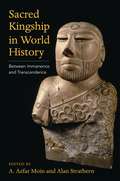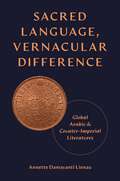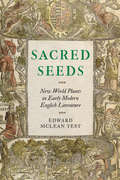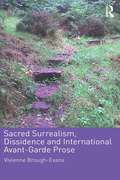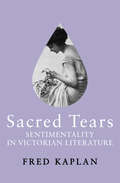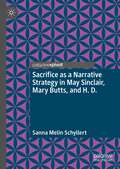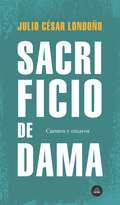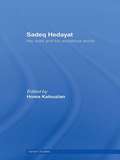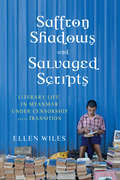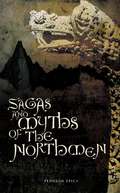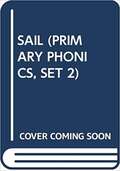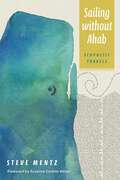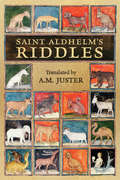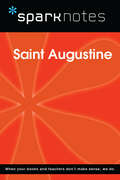- Table View
- List View
Sacred Kingship in World History: Between Immanence and Transcendence
by Moin, A. Azfar; Strathern, AlanSacred kingship has been the core political form, in small-scale societies and in vast empires, for much of world history. This collaborative and interdisciplinary book recasts the relationship between religion and politics by exploring this institution in long-term and global comparative perspective.Editors A. Azfar Moin and Alan Strathern present a theoretical framework for understanding sacred kingship, which leading scholars reflect on and respond to in a series of essays. They distinguish between two separate but complementary religious tendencies, immanentism and transcendentalism, which mold kings into divinized or righteous rulers, respectively. Whereas immanence demands priestly and cosmic rites from kings to sustain the flourishing of life, transcendence turns the focus to salvation and subordinates rulers to higher ethical objectives. Secular modernity does not end the struggle between immanence and transcendence—flourishing and righteousness—but only displaces it from kings onto nations and individuals. After an essay by Marshall Sahlins that ranges from the Pacific to the Arctic, the book contains chapters on religion and kingship in settings as far-flung as ancient Egypt, classical Greece, medieval Islam, Mughal India, modern European drama, and ISIS. Sacred Kingship in World History sheds new light on how religion has constructed rulership, with implications spanning global history, religious studies, political theory, and anthropology.
Sacred Language, Vernacular Difference: Global Arabic and Counter-Imperial Literatures (Translation/Transnation #52)
by Annette Damayanti LienauHow Arabic influenced the evolution of vernacular literatures and anticolonial thought in Egypt, Indonesia, and SenegalSacred Language, Vernacular Difference offers a new understanding of Arabic&’s global position as the basis for comparing cultural and literary histories in countries separated by vast distances. By tracing controversies over the use of Arabic in three countries with distinct colonial legacies, Egypt, Indonesia, and Senegal, the book presents a new approach to the study of postcolonial literatures, anticolonial nationalisms, and the global circulation of pluralist ideas.Annette Damayanti Lienau presents the largely untold story of how Arabic, often understood in Africa and Asia as a language of Islamic ritual and precolonial commerce, assumed a transregional role as an anticolonial literary medium in the nineteenth and twentieth centuries. By examining how major writers and intellectuals across several generations grappled with the cultural asymmetries imposed by imperial Europe, Lienau shows that Arabic—as a cosmopolitan, interethnic, and interreligious language—complicated debates over questions of indigeneity, religious pluralism, counter-imperial nationalisms, and emerging nation-states.Unearthing parallels from West Africa to Southeast Asia, Sacred Language, Vernacular Difference argues that debates comparing the status of Arabic to other languages challenged not only Eurocentric but Arabocentric forms of ethnolinguistic and racial prejudice in both local and global terms.
Sacred Realism: Religion and the Imagination in Modern Spanish Narrative
by Noel ValisIn this thoughtful and compelling book, leading Spanish literature scholar Noël Valis re-examines the role of Catholicism in the modern Spanish novel. While other studies of fiction and faith have focused largely on religious themes, Sacred Realism views the religious impulse as a crisis of modernity: a fundamental catalyst in the creative and moral development of Spanish narrative.
Sacred Rhetorical Education in 19th Century America: Austin Phelps at Andover Theological Seminary (Routledge Studies in Rhetoric and Communication)
by Michael-John DePalmaThis book offers new insight into the ways rhetorical educators’ religious motives influenced the shape of nineteenth-century rhetorical education and invites scholars of writing and rhetoric to consider what the study of religiously-animated pedagogies might reveal about rhetorical education itself. The author studies the rhetorical pedagogy of Austin Phelps, the prominent preacher and professor of sacred rhetoric at Andover Theological Seminary, and his theologically-motivated adaptation of rhetorical education to fit the exigencies of preachers at the first graduate seminary in the United States. In disclosing how Phelps was guided by his Christian motives, the book offers a thorough examination of how professional rhetoric was taught, learned, and practiced in nineteenth-century America. It also provides an enriched understanding of rhetorical theories and pedagogies in American seminaries, and contributes deepened awareness of the ways religious motives can function as resources that enable the reshaping of rhetorical theory and pedagogy in generative ways. Exploring the implications of Phelps’s rhetorical theory and pedagogy for future studies of religious rhetoric, histories of rhetorical education, and twenty-first century writing pedagogy,this book will be essential reading for scholars and students of rhetoric, education, American history, religious education, and writing studies.
Sacred Seeds: New World Plants in Early Modern English Literature (Early Modern Cultural Studies)
by Edward McLean TestMore than five hundred years after the fact, present-day writers still use hyperbolic adjectives to describe the “discovery” of the Americas. Columbus’s crossing of the Atlantic—and the age of exploration that ensued—dramatically and forever changed the early modern world. The societies, economies, cultures, arts, and burgeoning sciences of Europe were quickly transformed by the ongoing encounter with the New World. The meeting of the New and the Old Worlds, however, was more than a meeting of disparate civilizations. It was also a confluence of exciting and often surprising associations that continually created new interfaces between materials and knowledge. The Western and Eastern Hemispheres, brought together by sailing ships for the first time on a large scale, helped create the global landscape we take for granted today. Central to this formative moment in global history were New World plants. The agriculture of indigenous peoples mythically and materially shaped English society and, subsequently, its literature in new and startling ways.Sacred Seeds examines New World plants—tobacco, amaranth, guaiacum, and the prickly pear cactus—and their associated Native myths as they moved across the Atlantic and into English literature. Edward McLean Test reinstates the contributions of indigenous peoples to European society, charting an alternative cultural history that explores the associations and assemblages of transatlantic multiplicity rather than Eurocentric homogeny.
Sacred Surrealism, Dissidence and International Avant-Garde Prose (Studies in Surrealism)
by Vivienne Brough-EvansVivienne Brough-Evans proposes a compelling new way of reevaluating aspects of international surrealism by means of the category of divin fou, and consequently deploys theories of sacred ecstasy as developed by the Collège de Sociologie (1937–39) as a critical tool in shedding new light on the literary oeuvre of non-French writers who worked both within and against a surrealist framework. The minor surrealist genre of prose literature is considered herein, rather than surrealism's mainstay, poetry, with the intention of fracturing preconceptions regarding the medium of surrealist expression. The aim is to explore whether International surrealism can begin to be more fully explained by an occluded strain of 'dissident' surrealist thought that searches outside the self through the affects of ekstasis. Bretonian surrealism is widely discussed in the field of surrealist studies, and there is a need to consider what is left out of surrealist practice when analysed through this Bretonian lens. The Collège de Sociologie and Georges Bataille's theories provide a model of such elements of 'dissident' surrealism, which is used to analyse surrealist or surrealist influenced prose by Alejo Carpentier, Leonora Carrington and Gellu Naum respectively representing postcolonial, feminist and Balkan locutions. The Collège and Bataille's 'dissident' surrealism diverges significantly from the concerns and approach towards the subject explored by surrealism. Using the concept of ekstasis to organise Bataille's theoretical ideas of excess and 'inner experience' and the Collège's thoughts on the sacred it is possible to propose a new way of reading types of International surrealist literature, many of which do not come to the forefront of the surrealist literary oeuvre.
Sacred Tears: Sentimentality in Victorian Literature
by Fred KaplanAn absorbing study of the evolution of sentiment in Victorian life and literatureWhat is sentimentality, and where did it come from? For acclaimed scholar and biographer Fred Kaplan, the seeds were planted by the British moral philosophers of the eighteenth century. The Victorians gained from them a theory of human nature, a belief in the innateness of benevolent moral instincts; sentiment, in turn, emerged as a set of shared moral feelings in opposition to both scientific realism and the more ego-driven energies of Romanticism. Sacred Tears investigates the profound ways in which seminal writers Charles Dickens, William Makepeace Thackeray, and Thomas Carlyle were influenced by the philosophies of David Hume and Adam Smith, and by novelists of the same period. Exploring sentiment in its original context—one often forgotten or overlooked—Kaplan&’s study is a stimulating fusion of intellectual history and literary criticism, and holds no small importance for questions of art and morality as they exist today.
Sacrifice as a Narrative Strategy in May Sinclair, Mary Butts, and H. D.
by Sanna Melin SchyllertThis book explores sacrifice as a narrative theme and a stylistic strategy in works by May Sinclair, Mary Butts and H. D. It argues that the modernist experiment with pronoun use informs the treatment of acts of sacrifice in the texts, understood both as acts of self-renunciation and as ritual performance. It also suggests that sacrifice, if the conditions are right, can serve as the structure upon which a cohesive community might be built. The book offers in-depth analyses of the three authors and their works, deftly dissecting the modernist narrative experiment to show that it was by no means limited — it was a means by which to approach a wide range of stories and materials.
Sacrificio de dama
by Julio Cesar LondoñoEste libro reúne los mejores cuentos y ensayos del gran escritor caleño Julio César Londoño. Sacrificio de dama reúne lo mejor de la narración breve de Julio César Londoño, un escritor apasionado del cuento y del ensayo. En sus ensayos se empeña en acercar al hombre común la obra del genio. Concisos, transparentes, agudos, versan sobre tópicos tan diversos como la moda, los números, los sentidos, las hormigas, el ocio, la Torre de Babel, la obra ensayística de Borges, la relación entre Mutis y Poniatowska o la mítica derrota de Gary Kasparov, el mejor jugador de ajedrez de todos los tiempos, a manos de un computador. En sus cuentos hay el mismo afán de cautivar al lector, el mismo desenfado para narrar combinado con un cuidado musical de la forma, la misma erudición, la misma variedad temática, a veces las mismas obsesiones, y protagonistas tan atractivos como el caballo de Troya, Cristóbal Colón, Rufino José Cuervo, el cacique muisca Bechí, Johannes Kepler y Ramsés II.
Sadeq Hedayat: His Work and his Wondrous World (Iranian Studies)
by Homa KatouzianFeaturing contributions from leading scholars of Iranian studies and / or comparative literature, this edited comprehensive and critical edited collection provides detailed scholarly analysis of Hedayat's life and work using a variety of methodological and conceptual approaches. Hedayat is the author of The Blind Owl, the most famous Persian novel both in Iran and in Europe and America. Many of his short stories are in a critical realist style and are regarded as among some of the best written in twentieth century Iran. But his most original contribution was the use of modernist, more often surrealist, techniques in Persian fiction. Thus, he was not only a great writer, but also the founder of modernism in Persian fiction. Yet both Hedayat’s life and his death came to symbolize much more than leading writers would normally claim. He still towers over modern Persian fiction and will remain a highly controversial figure so long as the clash of the modern and the traditional, the Persian and the European, and the religious and the secular, has not led to a synthesis and a consensus.
Safer Sex in Personal Relationships: The Role of Sexual Scripts in HIV Infection and Prevention (LEA's Series on Personal Relationships)
by Mike Allen Tara M. Emmers-SommerThis book focuses on safer sex discussion and practice in close, personal relationships, emphasizing research on individuals in personal relationship types that are experiencing a rise in HIV infection and AIDS. Moving beyond studies of gay adult males and IV drug-users, this work paints a clear picture of the very real risk that exists for these less-studied, more general populations, so individuals may better personalize the risk and engage in more preventative measures. Authors Tara M. Emmers-Sommer and Mike Allen examine issues surrounding safer sex, utilizing research that focuses on how individuals struggle with personalizing the HIV and AIDS risk and how they cope with safer sex issues.Safer Sex in Personal Relationships takes readers on a journey through a variety of close relationship types. It begins by highlighting awareness to the global enormity of HIV and AIDS and providing a link between the global and personal, and the need to make HIV and AIDS awareness part of everyday talk and personal relationship structure. It then focuses on:*safer sex in close relationships, both heterosexual and homosexual;*marital relationships and the importance of safe sex discussion and awareness in marriages;*HIV and AIDS from a multicultural perspective;*HIV and AIDS in aged populations; and*increasing awareness, understanding, and compassion of those living with HIV and AIDS.This book will appeal to scholars and students concerned with HIV and AIDS in personal relationships. It will be an invaluable text for courses on interpersonal communication and relationships; family, marital, human sexuality, sex and gender, gay and lesbian relationships, and sexual education; and relational conflict across communication, psychology, and sociology disciplines.
Saffron Shadows and Salvaged Scripts
by Ellen WilesUntil 2012, Myanmar had been ruled for fifty years by one of the most paranoid and repressive censorship regimes in history. The military junta enforced strict reading and writing restrictions in line with their socialist ideology and was terrified of writers who could trigger change.Transition has lifted the worst restrictions, initiating a new era in the country's literature and literary culture. Inspired by Ellen Wiles's hunt for contemporary writing while living in Myanmar in 2013, this book explores the experiences and recent output of nine Myanmar writers spanning three generations, featuring interviews and English-language translations of their work, along with political, legal, and artistic analyses. Wiles includes men and women, fiction and poetry, capturing the effects of political and cultural change as they rippled across different groups and genres. Her work contributes both to the general study of art under censorship and beyond to Myanmar's democratic renaissance.
Saffron Shadows and Salvaged Scripts: Literary Life in Myanmar Under Censorship and in Transition
by Ellen WilesThis book tells an ethnographic story of a secret literary culture that has recently emerged from its cocoon. Until 2012, Myanmar (also known as Burma) was ruled for fifty years by one of the most paranoid and repressive censorship regimes in history. The military junta enforced strict reading and writing restrictions in line with their ideology, feared writers' potential to trigger change, and did their best to keep Western books and influences out of the country. As part of an unexpected move toward democracy, the government has recently lifted the worst restrictions on reading and writing, giving rise to a new era in the country's literature and literary culture. While living in Myanmar in 2013, Ellen Wiles sought out the best of its contemporary writers and writing to begin uncovering the country's remarkable literary life and history. This book contains the experiences and recent output of nine Myanmar writers spanning three generations, featuring interviews and English-language translations of their work, along with political, legal, and artistic explorations. It includes men and women, fiction and poetry, reflecting the ripples of political and cultural change as they have moved across different groups and genres. A rare portrait of a people and place in transition, Wiles's work contributes both to the study of literature and culture in Myanmar and to the general study of art under censorship.
Sag mal: An Introduction to German Language and Culture
by Tobias Barske Christinae AntonSag mal gives introductory students a comprehensive overview of German language and culture. Students incorporate structures and vocabulary from a variety of sources including text, video, and live communication practice, with opportunities for skill-building in every lesson.
Sagas and Myths of the Northmen
by Jesse ByockIn a land of ice, great warriors search for glory...When a dragon threatens the people of the north, only one man can destroy the fearsome beast. Elsewhere, a mighty leader gathers a court of champions, including a noble warrior under a terrible curse. The Earth's creation is described; tales of the gods and evil Frost Giants are related; and the dark days of Ragnarok foretold.Journey into a realm of legend, where heroes from an ancient age do battle with savage monsters, and every man must live or die by the sword ...
Sagas of Warrior-poets
by Leifur EirickssonKormak's Saga, The Saga of Hallfred Troublesome-Poet, The Saga of Gunnlaug Serpent-Tongue, The Saga of Bjorn, Champion of the Hitardal People, Viglund's Saga Set in the farmsteads of Viking age Iceland at a time when the old ethos of honour and heroic adventure merged with new ideas of romantic infatuation, each of these sagas features poet heroes, complex love triangles, and travels to foreign lands.
Sahayak Vachan class 8 - SCERT Raipur - Chhattisgarh Board: सहायक वाचन ८वीं कक्षा - एस.सी.ई.आर.टी. रायपुर - छत्तीसगढ़
by Raipur C. G. Rajya Shaikshik Anusandhan Aur Prashikshan Parishadपाठ्य सामग्री का चुनाव छात्रों की मानसिक क्षमता व रूचि को ध्यान में रखकर किया गया है। केन्द्रित शिक्षाक्रम में सम्मिलित मूल्यों के समावेश का पाठों के चयन में विशेष ध्यान रखा गया है। कक्षा 8वीं में अध्ययनरत् विद्यार्थियों के लिए इस पुस्तक को विषय 'हिन्दी - छत्तीसगढ़ भारती' में सहायक पुस्तक के रूप में स्वीकृत किया गया है, इससे बच्चों में पठन, वाचन, तर्क एवं चिंतन क्षमता विकसित होगी। प्रत्येक पाठ के अन्त में विस्तृत प्रश्न और अभ्यास दिए गए है जिनसे छात्रों को पठित वस्तु को समझने, उस पर विचार करने की योग्यता और भाषा का प्रभावी प्रयोग करने में सहायता मिलेगी व क्रियात्मक अभ्यासों की गतिविधियाँ करने से भाषाई दक्षताओं का विकास हो सकेगा। पुस्तक के अन्त में शब्दार्थ भी दिए गए हैं। भाषा शिक्षण का मुख्य उद्देश्य छात्रों को ज्ञान और आनन्द की प्राप्ति हो। यह एक संकलित दस्तावेज है और दस्तावेजों (पुस्तक) में प्रयुक्त शब्दों में बदलाव नही किया जा सकता है, अतः माननीय न्यायालय के निर्णय का सम्मान करते हुए दस्तावेज में प्रयुक्त मूल शब्दों के साथ ही इसे मुद्रित कराया गया है।
Sahitya Srijan First Semester FYBA New NEP Syllabus - SPPU: साहित्य सृजन पहला सत्र एफ.वाय.बी.ए. नया एन.इ.पी. पाठ्यक्रम - सावित्रीबाई फुले पुणे यूनिवर्सिटी
by Prof. Dr. Sadanand Bhosale"साहित्य सृजन" पुस्तक सावित्रीबाई फुले पुणे विश्वविद्यालय (SPPU) द्वारा तैयार की गई है और इसे नवीन राष्ट्रीय शैक्षणिक धोरण (NEP) 2020 के अंतर्गत पाठ्यक्रम में शामिल किया गया है। संपादक प्रो. डॉ. सदानंद भोसले और सह-संपादकों के निर्देशन में तैयार इस संग्रह में हिंदी साहित्य की विभिन्न विधाओं को प्रासंगिक उदाहरणों और चयनित कृतियों के माध्यम से प्रस्तुत किया गया है। यह पुस्तक अध्ययन, अध्यापन और मूल्यांकन के लिए उपयोगी है, जिसमें साहित्य के विविध पक्षों का विस्तार से विश्लेषण किया गया है। संपादकीय दृष्टि से और छात्र उपयोगिता को ध्यान में रखते हुए, इसे हिंदी साहित्य के अध्ययन के लिए एक प्रभावी संसाधन के रूप में संजोया गया है।
Sahityamela Bangla class 6 - West Bengal Board: সাহিত্যমেলা বাংলা ষষ্ঠ শ্রেণি
by West Bengal Board of Secondary Educationসাহিত্যমেলা-VI হল ষষ্ঠ শ্রেণির বাংলা সাহিত্য পাঠ্যপুস্তক, যা পশ্চিমবঙ্গ মধ্যশিক্ষা পর্ষদ কর্তৃক প্রকাশিত। এটি বাংলা সাহিত্যকে ছাত্র-ছাত্রীদের জন্য সহজ ও আকর্ষণীয় করে তোলার উদ্দেশ্যে রচিত হয়েছে। বইটি জাতীয় পাঠ্যক্রমের রূপরেখা ২০০৫ এবং শিক্ষার অধিকার আইন ২০০৯ অনুসারে তৈরি করা হয়েছে। এতে বাংলা ভাষার বিশিষ্ট সাহিত্যিকদের গল্প, কবিতা, প্রবন্ধ এবং আন্তর্জাতিক ও ভারতীয় সাহিত্যের অনুবাদ সংকলিত হয়েছে। বইটির বিশেষ আকর্ষণ হলো "হাতে-কলমে" বিভাগ, যা শিক্ষার্থীদের সৃজনশীলতা ও বিশ্লেষণ ক্ষমতা বৃদ্ধিতে সহায়ক। বইটি পাঠকদের কল্পনাশক্তি বিকাশ, সাহিত্য অনুরাগ গঠন এবং ভাষা দক্ষতা উন্নত করার লক্ষ্য নিয়ে পরিকল্পিত হয়েছে।
Sailing without Ahab: Ecopoetic Travels
by Steve MentzJourney through uncharted literary waters and explore Melville’s epic in bold new lightCome sail with I.We’re not taking the same trip, though you might recognize the familiar course. This time, the Pequod’s American voyage steers its course across the curvature of the Word Ocean without anyone at the helm. We are leaving one man and his madness on shore. Our ship overflows with glorious plurality—multiracial, visionary, queer, conflicted, polyphonic, playful, violent. But on this voyage something is different. Today we sail headless without any Captain. Instead of binding ourselves to the dismasted tyrant’s rage, the ship’s crew seeks only what we will find: currents teeming with life, a blue-watered alien globe, toothy cetacean smiles from vasty deeps. Treasures await those who sail without.This cycle of one hundred thirty-eight poems—one for each chapter in Moby-Dick, plus the Etymology, Extracts, and Epilogue—launches into oceanic chaos without the stabilizing mad focus of the Nantucket captain. Guided by waywardness and curiosity, these poems seek an alien ecopoetics of marine depths, the refraction of light, the taste of salt on skin. Directionless, these poems reach out to touch oceanic expanse and depth. It’s not an easy voyage, and not a certain one. It lures you forward. It has fixed its barbed hook in I.Sailing without means relinquishing goals, sleeping at the masthead, forgetting obsessions. I welcome you to trace wayward ways through these poems. Read them any way you can—back to front, at random, sideways, following the obscure promptings of your heart. It’s the turning that matters. It’s a blue wonder world that beckons.
Sails of the Herring Fleet
by Herbert BlauSails of the Herring Fleet traces esteemed director and theorist Herbert Blau's encounters with the work of Samuel Beckett. Blau directed Beckett's plays when they were still virtually unknown, and for more than four decades has remained one of the leading interpreters of his work. In addition to now-classic essays, the collection includes early program notes and two remarkable interviews -- one from Blau's experience directing Waiting for Godot at San Quentin prison, and one from his last visit with Beckett, just before the playwright's death. Herbert Blau is Byron W. and Alice L. Lockwood Professor of the Humanities, University of Washington.
Saint Aldhelm's 'Riddles'
by Juster A. M. Saint AldhelmThe first and one of the finest Latin poets of Anglo-Saxon England, the seventh-century bishop Saint Aldhelm can justly be called "Britain's first man of letters." Among his many influential poetic texts were the hundred riddles that made up his Aenigmata. In Saint Aldhelm's Riddles, A.M. Juster offers the first verse translation of this text in almost a century, capturing the wit, warmth, and wonder of the first English riddle collection.One of today's finest formalist poets, A.M. Juster brings the same exquisite care to this volume as to his translations of Horace ("The best edition available of the Satires in English" -Choice), Tibullus ("An excellent new translation" -The Guardian), and Petrarch. Juster's translation is complemented by a newly edited version of the Latin text and by the first scholarly commentary on the Aenigmata, the result of exhaustive interdisciplinary research into the text's historical, literary, and philological context. Saint Aldhelm's Riddles will be essential for scholars and a treasure for lovers of Tolkien, Beowulf, and Harry Potter.
Saint Augustine (SparkNotes Philosophy Guide)
by SparkNotesSaint Augustine (SparkNotes Philosophy Guide) Making the reading experience fun! SparkNotes Philosophy Guides are one-stop guides to the great works of philosophy–masterpieces that stand at the foundations of Western thought. Inside each Philosophy Guide you&’ll find insightful overviews of great philosophical works of the Western world.
Saint Marks: Words, Images, and What Persists
by Jonathan GoldbergSaint Marks invokes and pluralizes the figure of Mark in order to explore relations between painting and writing. Emphasizing that the saint is not a singular biographical individual in the various biblical and hagiographic texts that involve someone so named, the book takes as its ultimate concern the kinds of material life that outlive the human subject.From the incommensurate, anachronic instances in which Saint Mark can be located—among them, as Evangelist or as patron saint of Venice—the book traces Mark’s afterlives within art, sacred texts, and literature in conversation with such art historians and philosophers as Aby Warburg, Giorgio Agamben, Georges Didi-Huberman, T. J. Clark, Adrian Stokes, and Jean-Luc Nancy. Goldberg begins in sixteenth-century Venice, with a series of paintings by Gentile and Giovanni Bellini, Tintoretto, and others, that have virtually nothing to do with biblical texts. He turns then to the legacy of John Ruskin’s Stones of Venice and through it to questions about what painting does as painting. A final chapter turns to ancient texts, considering the Gospel of St. Mark together with its double, the so-called Secret Gospel that has occasioned controversy for its homoerotic implications.The posthumous persistence of a life is what the gospel named Mark calls the Kingdom of God. Saints have posthumous lives; but so too do paintings and texts. This major interdisciplinary study by one of our most astute cultural critics extends what might have been a purely theological subject to embrace questions central to cultural practice from the ancient world to the present.
